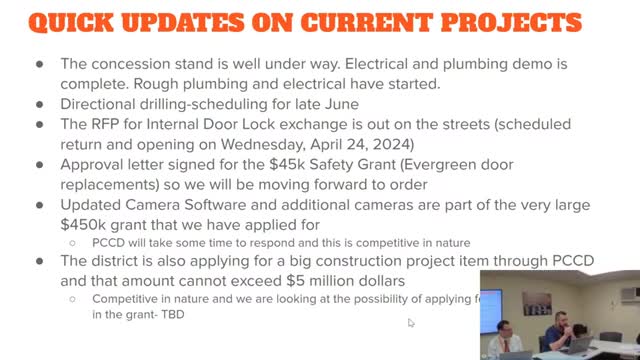School Board Proposes $50K Vape Detector Installation to Combat Vaping Crisis
March 21, 2024 | Perkiomen Valley SD, School Districts, Pennsylvania

This article was created by AI summarizing key points discussed. AI makes mistakes, so for full details and context, please refer to the video of the full meeting. Please report any errors so we can fix them. Report an error »

The Perkiomen Valley School District's Safety and Operations Committee convened on March 21, 2024, to address pressing issues surrounding student safety and operational efficiency, particularly focusing on the growing concern of vaping in schools. The meeting highlighted the district's ongoing efforts to implement vape detectors in high school bathrooms as a proactive measure against this escalating problem.
During the discussions, committee members emphasized the need for consistency in the identification and monitoring of staff and students within the school environment. A suggestion was made to standardize the numbering system for building monitors to enhance clarity and efficiency across all school facilities. This move aims to streamline operations and ensure that all personnel are easily identifiable, which is crucial for maintaining a safe school environment.
The primary focus of the meeting was the introduction of vape detectors, which have been piloted in select bathrooms at the high school. These devices are designed to detect low levels of THC and other chemicals associated with vaping, alerting administration discreetly when usage is detected. The pilot program reportedly identified several vaping incidents, indicating the potential effectiveness of these detectors in curbing the issue. The committee discussed the installation of 20 additional detectors throughout the high school, with the possibility of expanding this number based on initial results.
Concerns were raised about the financial implications of this initiative, with estimates for the installation of the detectors and necessary cameras ranging from $50,000 to $60,000. The committee acknowledged the need for a thorough evaluation of the cost-benefit ratio of such an investment, considering the significant time and resources currently allocated to managing vaping incidents.
Moreover, the committee recognized the importance of clear communication with parents regarding the implementation of these measures. It was suggested that a robust communication strategy be developed to inform families about the reasons behind the installation of vape detectors and the potential consequences for students caught vaping.
In conclusion, the meeting underscored the district's commitment to addressing vaping and enhancing student safety through innovative solutions. The anticipated next steps include finalizing the installation of vape detectors, assessing their effectiveness, and ensuring that all stakeholders are informed and engaged in the process. The committee's proactive approach reflects a broader trend in educational institutions to adapt to emerging challenges in student behavior and safety.
During the discussions, committee members emphasized the need for consistency in the identification and monitoring of staff and students within the school environment. A suggestion was made to standardize the numbering system for building monitors to enhance clarity and efficiency across all school facilities. This move aims to streamline operations and ensure that all personnel are easily identifiable, which is crucial for maintaining a safe school environment.
The primary focus of the meeting was the introduction of vape detectors, which have been piloted in select bathrooms at the high school. These devices are designed to detect low levels of THC and other chemicals associated with vaping, alerting administration discreetly when usage is detected. The pilot program reportedly identified several vaping incidents, indicating the potential effectiveness of these detectors in curbing the issue. The committee discussed the installation of 20 additional detectors throughout the high school, with the possibility of expanding this number based on initial results.
Concerns were raised about the financial implications of this initiative, with estimates for the installation of the detectors and necessary cameras ranging from $50,000 to $60,000. The committee acknowledged the need for a thorough evaluation of the cost-benefit ratio of such an investment, considering the significant time and resources currently allocated to managing vaping incidents.
Moreover, the committee recognized the importance of clear communication with parents regarding the implementation of these measures. It was suggested that a robust communication strategy be developed to inform families about the reasons behind the installation of vape detectors and the potential consequences for students caught vaping.
In conclusion, the meeting underscored the district's commitment to addressing vaping and enhancing student safety through innovative solutions. The anticipated next steps include finalizing the installation of vape detectors, assessing their effectiveness, and ensuring that all stakeholders are informed and engaged in the process. The committee's proactive approach reflects a broader trend in educational institutions to adapt to emerging challenges in student behavior and safety.
View full meeting
This article is based on a recent meeting—watch the full video and explore the complete transcript for deeper insights into the discussion.
View full meeting